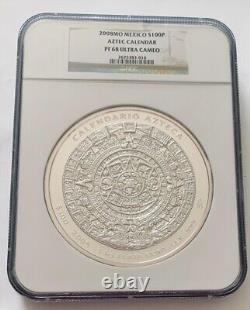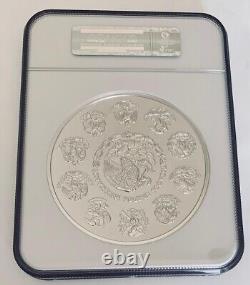
- Homepage
- Certification
- Authentic (4)
- Brilliant Unc (3)
- British Royal Mint (6)
- Certified (15)
- Certified By Mint (4)
- Chinese Mint (3)
- Coa (6)
- Legal Tender (3)
- Mint Certification (4)
- Mint Certified (11)
- Ngc (486)
- Pcgs (59)
- Pert Mint (6)
- Perth Mint (14)
- Perth Mint Coin (13)
- Rcm (21)
- Royal Canadian Mint (3)
- The Perth Mint (3)
- Uncertified (1843)
- Yes (3)
- Other (420)
- Composition
- Denomination
- Fineness
- Grade
- Antiqued (5)
- Gem Bu (5)
- Ms 69 (95)
- Ms 70 (91)
- Ms 70 Early Releases (4)
- Ms 70 First Releases (6)
- Pf 68 Ultra Cameo (4)
- Pf 69 Ultra Cameo (6)
- Pf 70 (13)
- Pf 70 Ultra Cameo (7)
- Pf70 (10)
- Pf70 Ultra Cameo (6)
- Pl 69 (3)
- Pr 67 (3)
- Pr 68 (9)
- Pr 69 (61)
- Pr 70 (98)
- Proof (4)
- Reverse Proof (3)
- Ungraded (877)
- Other (1620)
- Year
2008 Mexico 100P Aztec Calendar NGC PF 68 Kilo Silver Coin




Pictures don't do it justice. Silver Kilo 2008 Aztec Calendar.
La Casa de Moneda de México (the Mexican Mint). Was established in 1535 and is the oldest mint in the Americas. Apart from manufacturing all the circulation coinage for Mexico, the mint also strikes coins in the very large.
The best known of these is the Libertad. Series of bullion coins, but the mint also issues other types. Aztec Calendar one kilogram of silver. Was first issued as a commemorative during a special event held at the Museo Nacional de Antropología located in Mexico City in 2007, and has been issued every year since. The reverse design depicts the. (Spanish: Piedra del Sol), also known as the. A late post-classic Mexica sculpture housed in the National Anthropology Museum in Mexico City, the most famous work of Mexica sculpture. It measures 3.6 metres in diameter, is 98 centimetres thick, and weighs 24,590 kg. Shortly after the Spanish conquest, the monolithic sculpture was buried in the Zócalo, the main square of Mexico City.It was rediscovered on 17 December 1790 during repairs on the Mexico City Cathedral. Following its rediscovery, the sun stone was mounted on an exterior wall of the cathedral, where it remained until 1885.
The stone was carved some time between 1502 and 1521. Although the exact date of its creation is unknown, the name glyph of the Aztec ruler Moctezuma II in the central disc dates the monument to his reign between 1502 and 1520. There are no clear indications about the authorship or purpose of the monolith, although there are certain references to the construction of a huge block of stone by the Mexicas in their last stage of splendor. According to Diego Durán, the emperor Axayácatl "was also busy in carving the famous and large stone, very carved where the figures of the months and years, days and weeks were sculpted". The obverse of the coin shows at its centre the Coat of Arms of Mexico, which depicts a Mexican (golden) eagle perched on a prickly pear cactus, facing left, devouring a rattlesnake.
The cactus is on a pedestal immersed in the Aztec symbol for water. Below, a wreath of oak and laurel leaves tied at its centre with a ribbon representing the flag of Mexico. The design is rooted in the legend that the Aztec people would know where to build their city once they saw an eagle eating a snake on top of a lake. To the people of Tenochtitlan (the pre-European capital), this symbol had strong religious connotations, and to the Europeans it came to symbolise the triumph of good over evil (with the snake sometimes representative of the serpent in the Garden of Eden).
Meaning United Mexican States in Spanish - which is the full official name of Mexico. Within a plain border, surrounding the Coat of Arms and the inscription is a wide rim in which there are ten more depictions of the Coat of Arms of Mexico, illustrating the different styles it had throughout its history (the oldest depicted on top is the prototype of the symbol as seen in the 1541 Codex Mendoza, then in chronological order clockwise). The reverse of the coin shows at its centre a detailed image of the Aztec Calendar Stone. Its centrepiece represents the face of the solar deity, Tonatiuh, which appears inside the glyph for "movement" (Nahuatl: Ollin), the name of the current era. The three concentric rings around this feature, respectively, the signs corresponding to the 20 days of the 18 months and five nemontemi (five extra intercalary days) of the Aztec solar calendar; geometric decorative motifs; and two fire serpents, Xiuhcoatl, characterised by the flames emerging from their bodies, the square shaped segments that make up their bodies, the points that form their tails, and their unusual heads and mouths.
At the very bottom of the surface of the stone, are human heads emerging from the mouths of these serpents. Around above in the rim, the inscription. Around below, the nominal face value. (one hundred Mexican Pesos), followed by the date of issue.
And the precious metal content. 1 kg PLATA PURA LEY.
(one kilogram of pure silver with purity 99.9%). Mint mark of the Mexican Mint (large letter M above which a small o) is in the rim on the right.

